|
| |
Pictureville Cinema,
Bradford, England
Cinerama and 70mm Luxury
|
This article first appeared in
..in 70mm
The 70mm Newsletter |
|
Article and pictures by:
Thomas Hauerslev |
Issue 45, June 1996 |
|
 The Pictureville cinema The Pictureville cinema
In West Yorkshire, in the
heart of Britain, one of the worlds most advanced cinemas is situated. Capable of
presenting not only 35mm and 70mm, but also Cinerama.
It is the only public theatre
left in the world capable of showing original 3-strip Cinerama. [Since
article was written, Seattle Cinerama and the Cinerama Dome in Los
Angeles, also has 3-strip Cinerama operational, ed]
There are two additional
3-strip cinemas, but they are private. (The New Neon in Dayton, USA has added a Cinerama
installation in 1996).
Originally there were more than 150 3-strip installations scattered
all over the globe. Pictureville Cinema, with its unique screen and sound technology, can
display 3 Cinerama projectors and one 35mm/70mm projector. With this collection of
equipment, only very few films cannot be shown there.
|
Further in 70mm reading:
Wide Screen
Weekend home
Projecting Cinerama @ the Pictureville
Just the facts please
Internet link:
Pictureville Cinema
National
Media Museum
Bradford BD1 1NQ
England
Phone: +44 (0)1274 20 20 30
|
Opening
Day
|
|
|
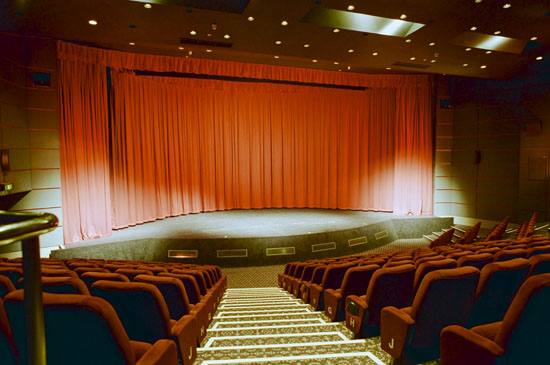 Pictureville cinema opened April 8, 1992 (1st Cinerama performance: June 16,
1993) with a charity performance of "Hook" in 70mm and 6- channel
stereophonic sound. Pictureville cinema opened April 8, 1992 (1st Cinerama performance: June 16,
1993) with a charity performance of "Hook" in 70mm and 6- channel
stereophonic sound.
For more than a year Pictureville ran 35mm and 70mm on the flat
screen. Many 70mm films from the collection of the museum, like "STAR!",
"Custer Of The West", "The Last Valley" and many others, are
frequent guests on the 70mm screen.
Pictureville Cinema is managed by National Museum of
Photography, Film and Television in Bradford (NMPFT).
The cinema itself is located inside an old theatre building. The
entrance is left of the NMPFT. Once inside you are greeted by friendly staff and a large
pin board with clippings from the films shown in the Pictureville Cinema.
There is a bar
behind the projection. An exhibition area with exits tells the story of Cinerama. Cinerama
camera number #1 is permanently exhibited.
From the box office, not
only tickets are for sale. Also a wide selection of sweets and sodas tempts the audience.
There are two entrances to the cinema on both sides of the B-projection room.
Once
inside this beautiful cinema, you find yourself "surrounded" by 306 seats, 3
projection rooms, JBL surround speakers and a large wide "Cinerama red" curtain.
The colours are kept in black, grey and red.
|
|
The Auditoria
|
|
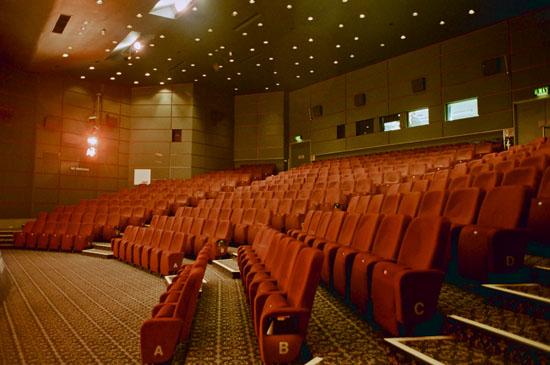 The seating area. Note Able projection to
the left. The seating area. Note Able projection to
the left.
306 seats including 2 wheel
chairs. The seating area is amphitheatrical and the view to the screen is unobstructed
by the viewer in front of you.
Row A is the first row nearest to the
screen(s).
There
are 12 rows A through M (I is missing).
The distance from row to row,
however, is objectionable. The distance is very short and can be uncomfortable when
viewing long films. Additionally when you have to move for late comers, you just have to
stand up. An extra foot of leg space would have been great. But that is the only
regret from this writer. In front of the screen(s) there is a small stage.
|
|
Projection Room
|
|
 The projection rooms are kept very clean. The Cinerama boxes Able
and Charly, situated in opposite sides of the cinema are clearly visible from the
auditoria. The projection rooms are kept very clean. The Cinerama boxes Able
and Charly, situated in opposite sides of the cinema are clearly visible from the
auditoria.
Inside there is an Cinemeccanica Victoria 8 Cinerama projector and a tower with
the large reel of film.
The centre box is also equipped with a 5-deck platter, a 35mm/70mm
Cinemeccanica Victoria 8 projector and the third Cinerama projector Baker. The B
Cinerama panel is not coming from a large 7000 ft reel like A and C panel, but from the
platter. Perhaps the first time Cinerama has been shown on platters.
The large
Cinemeccanica Cinerama sound 35mm dubber with a new sound head manufactured by Teccon is
also installed in Baker.
The amplifiers are QSC of which there are 6. The sound
system is a Dolby Laboratories model CP200 and the latest in digital technology is a SONY
SDDS reader. The main speakers in the cinema are Electro Voice and the surrounds are
JBL.
|
|
Screen Technology
|
|
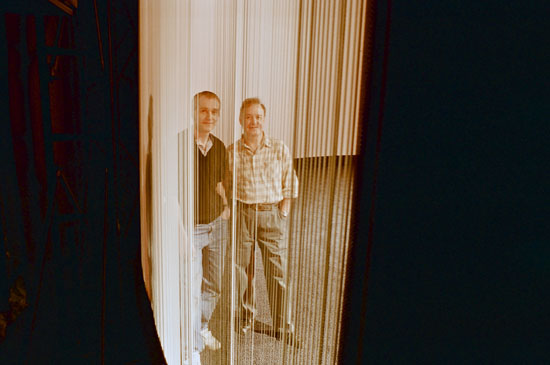 The Cinerama screen from the rear, or
actually from the left of the screen.
Projectionists Mr. Tony Cutts and Mr. Duncan McGregor are seen through
the screen.
Note the deep curvature and louvers. The Cinerama screen from the rear, or
actually from the left of the screen.
Projectionists Mr. Tony Cutts and Mr. Duncan McGregor are seen through
the screen.
Note the deep curvature and louvers.
The screen technology is very sophisticated. For ordinary film
presentations a 10,2 meter flat roller screen is used. Behind the roller screen are 5
speakers for 5 channel sound reproduction. All ordinary presentations are shown on this
screen.
The unique feature of Pictureville is the screen behind the roller screen.
Not only are two sets of projectors installed, but also two sets of screen/speakers and
curtains. The giant curved 146’ louvered Cinerama screen is revealed when the roller
screen and speakers are hoisted into the ceiling. The roller screen is manually controlled
from behind the screen.
The Cinerama screen is made of 1360
guided louvers each angled to the audience and the relevant projector. It is designed to
reduce cross reflection to a minimum.
The screen measures 146’ horizontally and
55’ vertically. The aspect ratio is 2,62:1. The relative aspect ratio seen straight
in front of the screen is 2,24:1 with a heavy butterfly effect because of the deep
146’ curvature. Behind the Cinerama screen 5 speakers are installed in a THX-like
wall for discrete 7 channel Cinerama sound.
|
|
|
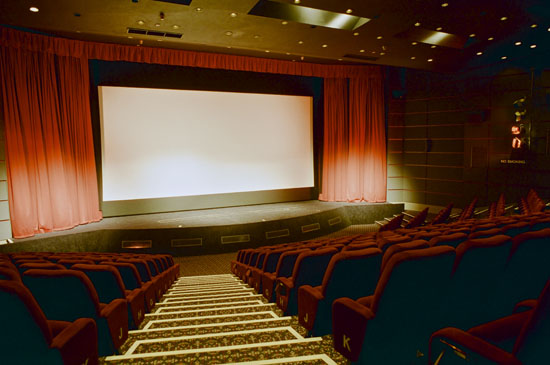 The flat screen. The flat screen.
The premiere of 3-strip Cinerama and re-
release of "This is Cinerama" took place June 16, 1993.
Present at that
performance was the widow of Fred Waller, the inventor.
"How The West Was
Won" was shown March 9, and March 10, 1996 during the Wide Screen Festival.
Additionally a work print of the new Kinopanorama film "Bounty" has been
shown on the Cinerama screen in 3 strip.
|
|
Next Door
|
|
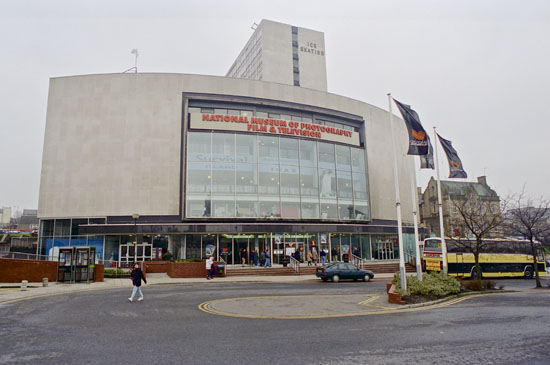 NMPFT
- National Museum of Photography, Film & Television NMPFT
- National Museum of Photography, Film & Television
Next door to Pictureville cinema the NMPFT is running a museum and the
only IMAX screen in the UK (until 1997.) More info about IMAX and NMPFT in a future
article in The 70mm Newsletter.
Even though Pictureville is located well
outside London it is very easy to reach. Out of many possible ways of getting to Bradford
including walking, by car or flying, the train from London is the obvious choice. With
departures every hour from London’s Kings Cross and a change in Leeds, the train ride
takes 3 hours. You will arrive at Bradford City Centre Interchange, only 5 minutes by foot
from Pictureville.
|
|
Screen & Projection
|
|
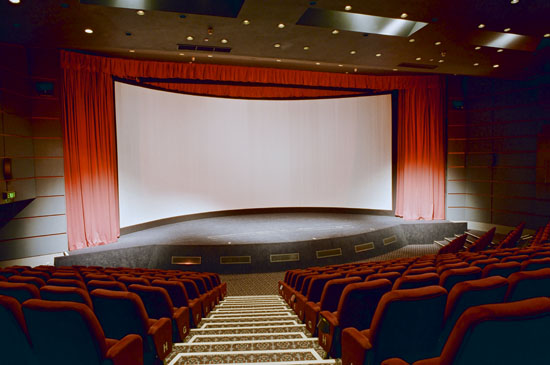 The Cinerama screen. The Cinerama screen.
Louvered 146° Cinerama screen. 15,6m (51’2") wide along the
curve. 5,9m (19’5") high. Screen supplied by Hurley Screen, Inc., Baltimore,
USA. Depth of curvature is 3,9m (12’11"). Screen chord is 13,0m
(42’8"). Throw to center of screen chord of Cinerama screen 18,1m
(59’4"). There are 1360 louvers.
Flat roller screen 10,2m (33’5") wide
and 4,6m (15’2") tall from Harkness, Ltd, England. Both screens are covered by a
"Cinerama Red" curtain.
3-Cinemeccanica Victoria
8 Cinerama projectors (Able, Baker & Charlie) electronically locked together by Selsyn
motors. 1-Cinemeccanica Victoria 8 70/35 projector. 1-Philips DP70 Todd-AO projector (To
be installed). Cinemeccanica CNR-5 70/35 non-rewind plattersystem with 5 decks.
3000 watt/110 amps Osram
xenon on each Cinerama projector. 4500 watt /140 amps Osram xenon on the Victoria 8 70/35
(and the DP70 when installed).
3-strip Cinerama is
operated by two projectionists. Projection lenses are from Schneider and ISCO in Germany.
Fixed lens on Baker. Zoom lenses on Able and Charlie.
Focal length on lens for
flat screen 70mm film is 85mm. Focal length for 70mm on Cinerama screen is 65mm.
|
|
Who Did It?
|
|
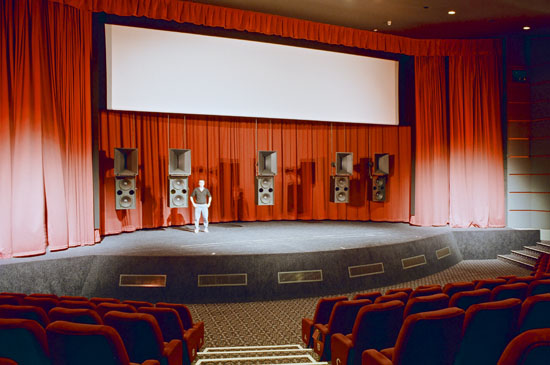 Roller screen, speakers and Mr. Duncan
McGregor on stage to illustrate the size of the screen. Roller screen, speakers and Mr. Duncan
McGregor on stage to illustrate the size of the screen.
The Cinerama installation were done by Technical Cinerama consultants
Willem Bouwmeester and John Harvey (The International Cinerama Society).
All missing
projector- and sound parts were collected from Helsinki, Finland (35mm dubber), Bruxelles,
Belgium (louvered screen supports), Paris, France (handmade sprockets by Cinemateriel),
Hollywood, USA ("This is Cinerama" negative and soundtrack restoration by
PixFix), Sound Associates (London), Teccon Enterprises (Los Angeles), Milan, Italy
(drawings supplied by Cinemeccanica). England and USA (louvered screen by Hurley Screen,
Inc., Baltimore, USA. Flat screen by Harkness Screens).
|
|
Sound Equipment
|
|
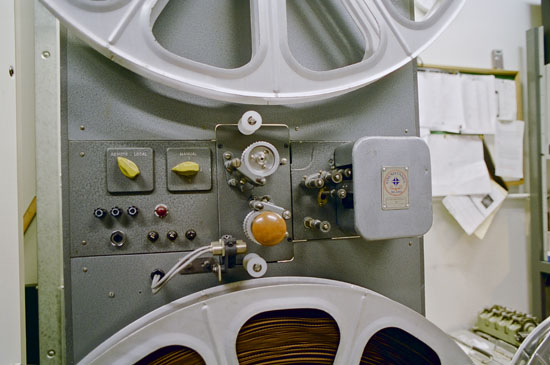 Cinemeccanica A6 Cinerama
Sound 35mm dubber with specially made Teccon 7-track Cinerama head. Cinemeccanica A6 Cinerama
Sound 35mm dubber with specially made Teccon 7-track Cinerama head.
Dolby Stereo CP200 cinema
sound processor. Dolby MPU-1 (Magnetic sound). Dolby SRA5 Spectral Recording. Dolby DA20
Dolby Digital. Sony Dynamic Digital Sound DFP-D2000 processor (SDDS). Digital Theater
Systems S—DTS-6 processor (DTS). 10-JBL 8330-DK surround speakers (Surrounds will be
upgraded soon). Electro Voice screen speakers. One set of 5 screen channels behind both
screens.
Amplifiers: 3-QSC USA 1300
(2x650 Watt) for screen speakers and 3-QSC USA 850 (2x425 watt) for subwoofer and
surrounds.
|
|
| |
|
Go: back
- top - back issues
Updated
22-01-25 |
|
|
 The projection rooms are kept very clean. The Cinerama boxes Able
and Charly, situated in opposite sides of the cinema are clearly visible from the
auditoria.
The projection rooms are kept very clean. The Cinerama boxes Able
and Charly, situated in opposite sides of the cinema are clearly visible from the
auditoria.  The Cinerama screen from the rear, or
actually from the left of the screen.
Projectionists Mr. Tony Cutts and Mr. Duncan McGregor are seen through
the screen.
Note the deep curvature and louvers.
The Cinerama screen from the rear, or
actually from the left of the screen.
Projectionists Mr. Tony Cutts and Mr. Duncan McGregor are seen through
the screen.
Note the deep curvature and louvers. NMPFT
- National Museum of Photography, Film & Television
NMPFT
- National Museum of Photography, Film & Television Roller screen, speakers and Mr. Duncan
McGregor on stage to illustrate the size of the screen.
Roller screen, speakers and Mr. Duncan
McGregor on stage to illustrate the size of the screen.
 The Pictureville cinema
The Pictureville cinema Pictureville cinema opened April 8, 1992 (1st Cinerama performance: June 16,
1993) with a charity performance of "Hook" in 70mm and 6- channel
stereophonic sound.
Pictureville cinema opened April 8, 1992 (1st Cinerama performance: June 16,
1993) with a charity performance of "Hook" in 70mm and 6- channel
stereophonic sound. The seating area. Note Able projection to
the left.
The seating area. Note Able projection to
the left. The flat screen.
The flat screen. The Cinerama screen.
The Cinerama screen. Cinemeccanica A6 Cinerama
Sound 35mm dubber with specially made Teccon 7-track Cinerama head.
Cinemeccanica A6 Cinerama
Sound 35mm dubber with specially made Teccon 7-track Cinerama head.